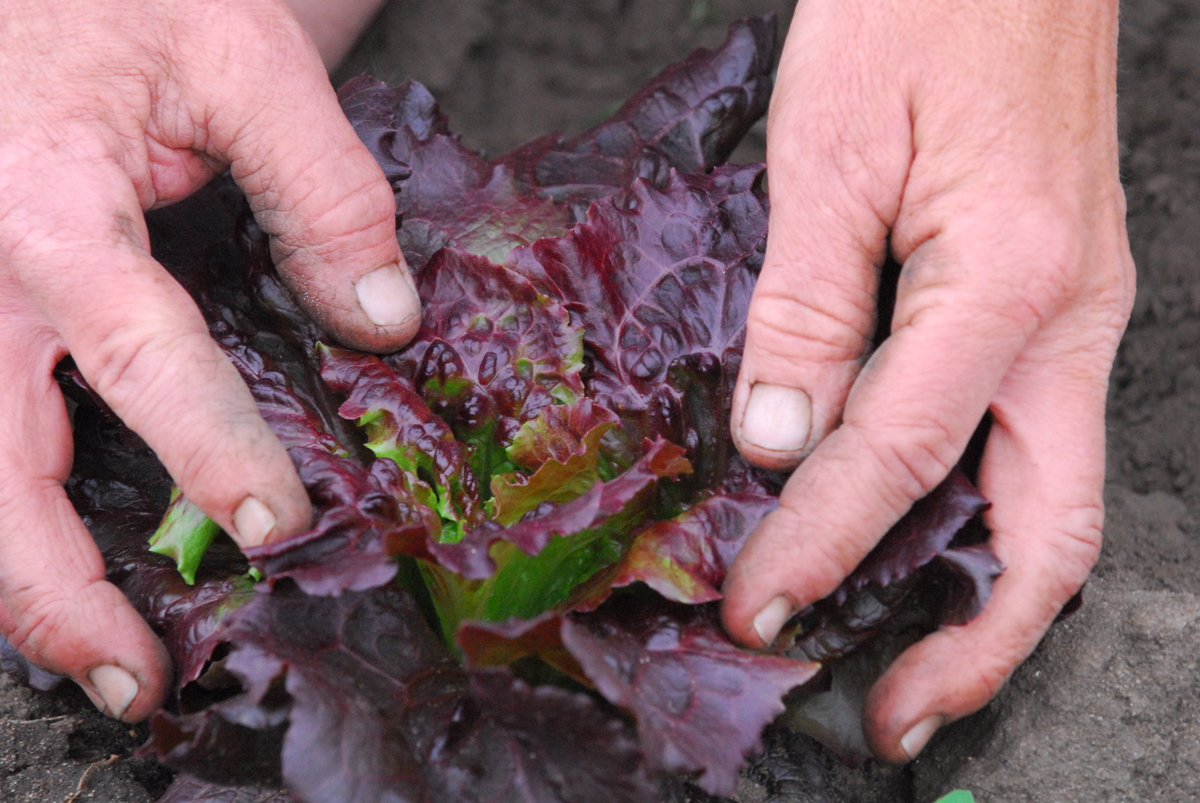Feed Iowa First! Make a New Year's Resolution to Plant a Giving Garden
On a recent trip to the Johnson County Crisis Center food bank in Iowa City I saw a table full of produce and recognized the name scrawled in permanent marker on the side of the box: Echollective Farm. In the box were all kinds of delicious looking things including beautiful leeks, various root vegetables and bunches of greens. This was a very different offering from the plethora of plastic bagged bread, rice, legumes and mass produced boxed or canned foods that usually lined the pantry shelves. Another box, unmarked but clearly not commercially farmed, was full of cucumbers, heirloom tomatoes of all sizes and colors and long stemmed garlic.
I wondered what kinds of hoops my farmer friends had to jump through to donate and whether the unmarked box had come from a farm or just a generous gardener. I watched as a young blond mother - with a toddler at her hip and wearing a baby - picked up some lettuce, inspected the leaves and asked another woman wearing a volunteer badge if the greens were organic. This food pantry client was visibly pleased when told that it was not only locally grown, but organic through and through.
Fresh produce is one of the top requests at most food banks, with a recent survey at the Johnson County Crisis Center indicating that 83% of the clients most want more fresh fruits and vegetables made available.
As any consumer knows, fresh items tend to be more expensive per calorie and per pound than much of the “middle aisle” foods. Most food banks have discounts or wholesale purchasing accounts with local growers and food service corporations, but with the recent drastic and historic cuts to the SNAP program, and with both food prices and demand for service up (12% in Iowa Cityalone), serving those in need is becoming increasingly difficult.
Food banks work year round to develop strong relationships with vendors at local farmer’s markets to buy excess and discounted produce for their clients, but multiple organizations and programs are working to encourage farmers and gardeners to donate garden yields to organizations that serve those in need.
Originally a Canadian organization, the Plant a Row program through the Hawkeye Area Community Action Program (HACAP) Food Reservoir has been working to encourage home gardeners “to continue the long-standing tradition of gardeners“ loving to share their harvest with others”.
The simple act of planting an extra row in one’s garden with the intention of donating those yields to a local food pantry might have been the origin of the unlabeled box of produce I saw at the food bank that day. A similar organization, AmpleHarvest.org campaigns to connect local gardeners with service agencies that can help distribute extra food from their gardens, who might not know that this is an option.
Local Foods Connection and Feed Iowa First are other great examples of how organizations advocating for healthful food for low income people are looking at the problem of food insecurity holistically, closing the loop between production and consumption. Nearing fifteen years of service, Local Foods Connection has been purchasing produce, bread, eggs, meat and other products from local earth-friendly farms, donating “these goods to families who cannot afford such nutritious, tasty and fresh food”.
With a vision of a “local, sustainable food system that is accessible to everyone,” Local Foods Connection helps to encourage the consumption of fresh, healthy food by creating opportunities for families to visit farms, learn how to cook healthy food and most importantly by buying locally they are strengthening the market for produce harvested from local farmers.
Though a much younger organization, Feed Iowa First is taking this movement one step further and strengthening the local foods network by trying to help place established, displaced or would-be farmers with rural or urban land or lots to farm, with the purpose of producing for those in need. Starting with only one acre of donated land in 2011, Feed Iowa First produced over one ton of vegetables for a local food bank. This past year the organization had increased its production to five or six acres of urban gardens. By 2050, the demand for food will increase by more than seventy percent.
Like their name says, Feed Iowa First is mostly focusing on Linn County for now, but they are setting an example and working through the challenges of turning mowed or vacant spaces into vegetable gardens with the purpose of the process being repeated throughout the state. Across the state of Iowa, advocates for urban gardening are helping to “un-pave” the way for Feed Iowa First’s efforts by challenging bans on front yard gardens and other conventional ideas of what yards “should” look like. In some cases, victories come in the form of large backyard greenhouses and edi- ble landscapes that lend homes real foodie “curb appeal.”
Corporations and businesses are even getting in on the action. Thirty 100-foot rows of tomatoes and onions were grown on land at Rockwell Collins’ C Avenue complex in Cedar Rapids and 2,000 asparagus plants were grown on a vacant lot owned by Horizons, A Family Service Alliance.
Across Feed Iowa First plots, volunteers farm the land and it is donated back to everyone from Meals on Wheels to local food banks. Across the state, the idea that mowable land can be turned into corporate service projects is catching on. The popular notion of team building among employees has found a new avenue in the vegetable rows, with the communal act of gardening for the common good. Churches, even municipalities and school districts are jumping in, allowing school gardens to be harvested for school lunches and garden plots are popping up in public places where transient or homeless people help cultivate and harvest food.
The moral: It’s easy, in the face of hunger and stories of growing food insecurity to feel helpless, but participating in a group garden or growing your own garden or row with the intention of giving is something you can do to help. Start planning to grow a “giving garden” in 2014 now and help spread the word.
How you can help:
- Join FeedIowa1st.org and LocalFoodsConnection.org
- Contact your local food bank or pantry to make a year end donation.
- Grow a “giving garden” and plant a row (GrowARow.org) to be donated and let your gardener friends know they can donate excess food to those in need.
- Volunteer at a local farm or Farmer’s Market stand and ask for donations for your local Food Bank in return. You’ll get great exercise and turn your time into fresh produce for those in need.





